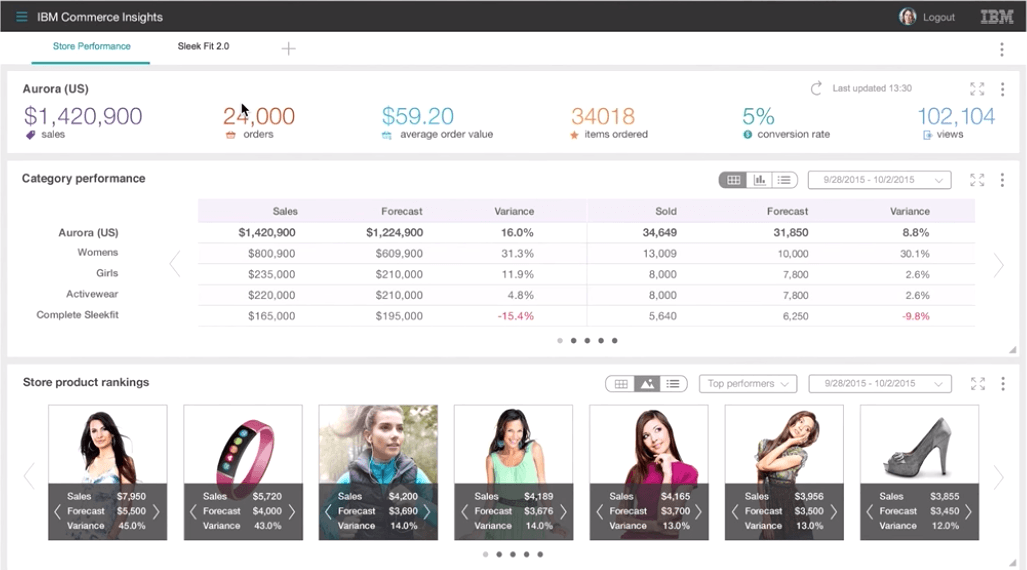Until recently, HCL Commerce customers have had a choice when dealing with visual merchandising for their online services. As of July 1, 2021, however, that alternative is no more. While the announcement was made back 2019, Commerce Insights has now been officially withdrawn from the market and will no longer be supported, leaving Smart Merchandiser the only remaining option.
End of life for Commerce Insights means different things for those businesses who were using it. A transition period will be necessary in order to learn the ropes of the new system and the ways it may affect your online merchandising options.
The bad news is that it’s not an instant switch. The good news is that Smart Merchandiser offers options that Commerce Insights didn’t, and with proper planning and adjustment, your business can make the leap and move forward with minimal disruption to your operations.
J.Jill: From IBM Watson Commerce Insights to Smart Merchandiser

J.Jill women’s apparel is a prime example of both the challenges faced by the end of Commerce Insights and the big benefits yielded by migrating to Smart Merchandiser.
HCL Technologies, which acquired a number of IBM software products in a 2019 merger between the companies, played a role in shifting the clothing company to a new visual merchandising software platform. J.Jill, an early adopter of Commerce Insights, invested a great deal of time and resources into it. When they were informed about the software’s end of life, they had some big decisions to make.
They reached out to HCL who in turn pointed to Smart Merchandiser. Planning the transition took two weeks, and J.Jill’s board unanimously voted to onboard. The process was seamless and J.Jill is now fully in production powered by Smart Merchandiser. They have found that the Smart Merchandiser met their needs adequately, and indeed, accomplished things that Commerce Insights did not have the capacity for. Naturally, with minimal disruption to their operations, J.Jill is delighted.
J.Jill is precisely the kind of business that might have taken a tremendous hit without a plan in place to transition, and an understanding of all the steps that entails. Their line covers a wide array of apparel in a huge number of styles and designs, as well as a full range of accessories including handbags, jewelry, and shoes. Their online merchandising plan relies on customers to be able to find precisely what they want from a vast array of combinations without difficulty, as well as on ancillary sales such as matching tops/bottoms to a given purchase or the right accessory for a given look.
All of that is heavily dependent on the visual aspects of its platform. Any disruption of its online platform, even for a short while, could have been disastrous. Smart preparation and full commitment to the transition process ensured they could continue without a hitch.
How Is Smart Merchandiser Different From IBM Watson Commerce Insights?
The first and most obvious benefit of Smart Merchandiser over Commerce Insights is that it has been on the market longer and had subsequent time for refinement and upgrades. That starts with improved versatility and usefulness.
From a technical perspective, Commerce Insights used Solr, a search platform-based Apache Lucene engine, to facilitate commerce indexing. It worked well, but it was version-specific, requiring extra time and resources to accommodate incompatible systems. Smart Merchandiser uses web services and APIs to access the pertinent database, which makes it a lot more versatile in terms of the systems it can function with. Important to note that every version of HCL Commerce is fully compatible with Smart Merchandiser, which means peace of mind when it comes to your ecommerce platform.
Commerce Insights possessed another shortcoming as well, one less notable. Because it functioned outside of CMC (Commerce Management Center), it rendered certain categories non-accessible to CMC. Commerce Insight would simply overwrite the CMC data each time it re-indexed. Smart Merchandiser does not have that problematic component, it remains fully functional within CMC, and it doesn’t require any workarounds to retain important data. That, in turn, facilitates better data integration: allowing your customers to find the items they need and for you to get it into their hands with no difficulties at all.
Furthermore, Smart Merchandiser features a number of options specifically aimed at clothing manufacturers that didn’t exist with its now-retired predecessor. That includes things like heatmapping, which uses color-coding to identify spikes or increases in data within seconds and is specifically designed to address the needs of the apparel industry. Color management is available as well, allowing customers to more rapidly find the shades they’re looking for, and to better connect with other products that may work well with their choices.
To return to the example of J.Jill, Smart Merchandiser not only allowed them to more effectively manage their website and help their customers find what they needed, but it did so without a major disruption to their day-to-day businesses. Handling end of life for Commerce Insights means being able to do that with your business as well.
Take Control of Your Storefront With Drag and Drop Simplicity
If you have been using Commerce Insights and you need an alternative, Smart Merchandiser is a swift and easily implemented solution. Besides its versatility with HCL Commerce, it now functions with the Salesforce Commerce Cloud (SFCC), giving you even more interconnectivity. And because Smart Manager accesses data via an application programming interface (API), it will soon be platform-independent, giving you the flexibility to address any similar changes that need to take place in the future.
If that sounds like a good fit for your company, then don’t waste any more time. With the right experts on your side, you can make the transition to Smart Merchandiser smoothly and move your company into the future. Schedule a demo today and discover how you can optimize your storefront and achieve higher sales.




